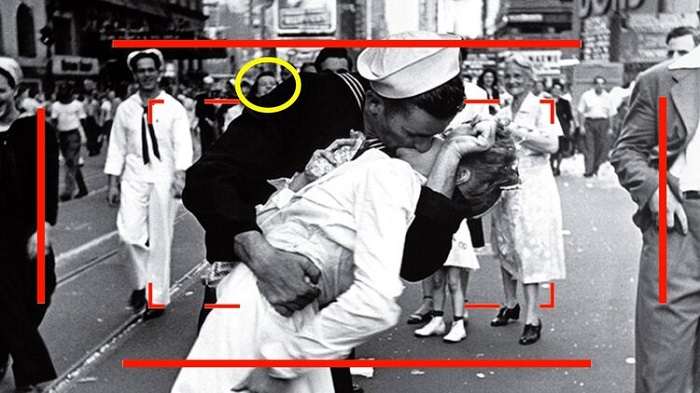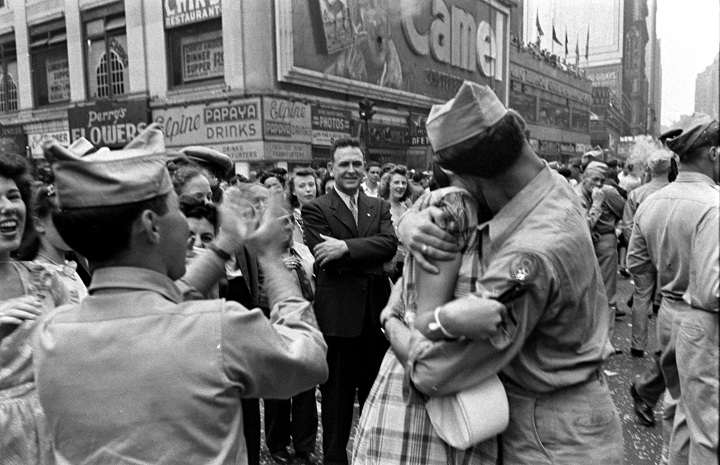The Context of VJ Day: A Nation Rejoices

Victory over Japan Day (VJ Day) marked the official end of World War II, after Japan’s surrender to the Allied forces. For nearly six years, the world had been engulfed in one of the deadliest and most widespread conflicts in human history. With the surrender of Japan, peace was finally at hand, and people across the globe erupted in celebration.
In the United States, particularly in New York City, the streets were filled with people who had lived through years of rationing, loss, and uncertainty. Times Square, the bustling heart of the city, became a focal point of the celebration as civilians, military personnel, and workers took to the streets, overwhelmed with joy. It was amidst this chaos and excitement that the famous kiss took place.
Capturing the Kiss: Alfred Eisenstaedt’s Role
Alfred Eisenstaedt, a German-born photographer working for Life Magazine, was roaming the streets of New York on VJ Day, capturing the spontaneous celebration. Armed with a Leica IIIa, Eisenstaedt knew that in moments like these, the best photographs were the ones that emerged organically.
While walking through Times Square, Eisenstaedt spotted a sailor and a nurse in the middle of a passionate kiss. He acted quickly, snapping four photos of the pair before they parted. He later recalled that the kiss was so quick and unscripted that he didn’t even get a chance to ask for the names of the subjects.
This photograph, which would become one of the most recognizable images in American history, was published in Life Magazine and soon became emblematic of the nation’s joy at the end of the war.
The Mystery of the Kissers: Who Were They?
One of the most intriguing aspects of the “VJ Day Times Square Kiss” is the mystery surrounding the identity of the sailor and the nurse. Since Eisenstaedt did not take down their names, their identities remained unknown for decades, leading to many people coming forward to claim they were either the sailor or the nurse in the photograph.
The Sailor: George Mendonsa
In 1980, George Mendonsa, a former sailor, came forward, claiming to be the man in the photo. He shared his story about being on leave from his service in the Pacific theater and celebrating the news of the war’s end with his then-girlfriend, Rita, who is seen smiling in the background of the photograph.
Mendonsa described how he was overcome with excitement and spontaneously grabbed the nearest woman to kiss her in celebration. Years later, photographic analysis and interviews with Mendonsa led many historians to conclude that he was indeed the sailor in the image.
The Nurse: Greta Zimmer Friedman
The identity of the nurse remained a subject of even greater debate. For decades, several women claimed to be the woman in the photograph, but in 1980, Greta Zimmer Friedman came forward, asserting that she was the one being kissed by Mendonsa.
Friedman, a dental assistant who had fled Nazi-occupied Austria, recalled being suddenly grabbed and kissed by the sailor. She later admitted that she did not know Mendonsa and that the kiss was not consensual but rather a spur-of-the-moment gesture. Still, her story matched the details of the image, and photographic analysis supported her claim as the woman in the photo.
The Story Behind the Kiss: A Spontaneous Moment or Something More?
The famous VJ Day kiss was widely perceived as a symbol of unbridled joy and relief, perfectly capturing the nation’s emotions at the end of the war. However, over time, the conversation around the image began to shift.
While many viewed the kiss as a joyous celebration of peace, others pointed out the underlying complexities. Greta Zimmer Friedman later stated that the kiss was not a romantic gesture and that she had not consented to it. This acknowledgment has led to discussions about consent, particularly in the context of public celebrations, and how the photograph should be interpreted in a modern light.
The Debate Over Consent
In the years since the photo was taken, discussions about the VJ Day kiss have evolved. For many, the kiss symbolized the end of a dark chapter in history, a moment of unity and happiness. However, as societal views on consent have evolved, some began to question the appropriateness of the kiss.
While neither Mendonsa nor Friedman ever expressed significant ill will toward each other, Friedman did admit that she was taken by surprise and had not expected or consented to the kiss. In interviews, she described the moment as being swept up in the sailor’s excitement, a moment she understood in context, but one she would not have chosen.
This reflection has prompted some to reevaluate the iconic image, considering it less as a pure symbol of joy and more as a moment emblematic of shifting cultural norms.
The Cultural Impact of the Photo
Despite the debates surrounding it, the “VJ Day Times Square Kiss” remains one of the most enduring symbols of World War II. It has been referenced in numerous films, television shows, and even parades. Many see the image as capturing a unique moment in time—a spontaneous, emotional outburst that marked the beginning of peace after years of global conflict.
Replications and Tributes
Over the years, the photo has been replicated and paid tribute to countless times. People have recreated the kiss at various events, including VJ Day anniversaries, and the image has become an iconic representation of post-war America.
One of the most well-known tributes is the “Unconditional Surrender” statue, a large-scale sculpture depicting the kiss, which has been displayed in cities such as San Diego, California, and Sarasota, Florida. The statue, designed by artist Seward Johnson, has drawn mixed reactions—some view it as a nostalgic tribute to an important moment in history, while others criticize it for glorifying a non-consensual kiss.
Pop Culture and the Media
The photo’s widespread appeal extends beyond its historical significance, making its way into pop culture. It has been referenced in movies like “The Great Gatsby” and television series like “Mad Men.” Its appearance in these modern contexts speaks to the photograph’s power to evoke a sense of nostalgia and patriotism.
Yet, even in these adaptations, the complexities of the image remain. Filmmakers and artists who use the photo often face the challenge of balancing its emotional impact with the more nuanced conversation about the nature of the kiss.
The Photograph’s Legacy: Celebration or Controversy?
The legacy of the “VJ Day Times Square Kiss” photo is complex. On the one hand, it remains an iconic image of joy, patriotism, and victory. For many people, it captures a moment in time when the world breathed a collective sigh of relief at the end of a devastating war.
On the other hand, modern discussions around consent have forced a reevaluation of the photograph. While the sailor and the nurse were caught up in the excitement of the moment, the question remains: should the spontaneous kiss be celebrated as an act of joy, or should it be criticized as a non-consensual act, emblematic of a different era’s social norms?
Related Post:
Give a Little Extra Flair with Up: Elevating Your Style and Space
The Ultimate Guide to McDonald’s $12 Dinner Box: A Delicious and Affordable Feast
The “VJ Day Times Square Kiss” photo endures as one of the most iconic images of the 20th century. It symbolizes both the end of a horrific war and the beginning of a complex dialogue about human interaction, consent, and the meaning of celebration.



